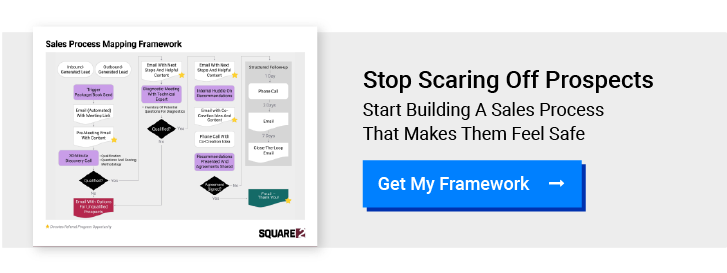
What Is Sales Enablement And What Are Its Benefits?
Marketplace disruptions have changed buying and selling behavior. Sales enablement tools and strategies are critical to adapting an inbound sales approach that meets the expectations of today’s buyers.
Sales teams need access to relevant content and up-to-date information that supports modern buyer behavior. According to statistics from HubSpot, only 19% of prospects want to connect with a salesperson during the Awareness Stage of the buyer journey. After they’ve done their own research and narrowed down a list of options, 60% of buyers are then ready to connect with a salesperson.
Prospective buyers use content to find answers to their questions. While they’re eventually likely to seek out salespeople, the process isn’t linear. Sales enablement gives your sales teams the tools and visibility needed to deliver personalized and expedited sales experiences.
What Is Sales Enablement?
Sales enablement is the ongoing effort to implement systems, processes and methodologies that enable salespeople to quickly turn leads into new customers.
The upshot of a good sales enablement framework is that success becomes measurable. Access to the right data unlocks insight into sales and marketing initiatives so organizations can better measure return on investment (ROI).
Today’s buyers are empowered with more information than ever before. They’re looking for educational content, data-driven insights and expert guidance that adds perspective and makes them feel more confident.
Why Is Sales Enablement Important?
The right sales enablement tools and strategies facilitate greater transparency across your organization. They improve the sales process, support sales teams with content and accelerate the sales cycle.
From an organizational perspective, sales enablement helps achieve several important goals:
- Align sales and marketing efforts to better serve customers
- Manage content to help salespeople guide buyers
- Run customized sales reports that track sales activities and communications
- Implement seamless integrations with technology tools
- Improve training and onboarding programs
Characteristics That Define Sales Enablement
Guiding Prospects, Not Selling To Them
How do you feel when a salesperson approaches you in a store? Do your defenses go up? Do you feel anxious? That's how your prospects feel when you try to sell. Now, how do you feel when a salesperson honestly appears to care about you and not just the sale? Maybe they offer educational material and make themselves available to answer questions. You’re more likely to be open to their help.
Sales enablement emphasizes the concept of guiding instead of selling. That starts with questions. By asking smart, strategic questions, you can provide the information and answers they need to make a confident buying decision. Questions also let you show prospects you have an interest in them and their challenges while providing yourself with the information to make personalized recommendations that fulfill their specific needs.
Tools And Technology Drive Results
Today’s sales environment is highly technical and digital. We have a wealth of tools, apps, and technologies at our disposal to improve sales processes and make sales reps’ lives easier. There’s a wealth of data we can take advantage of to learn more about our prospects, learn what’s working and what’s broken in the sales process, and learn how to improve.
Sales enablement is largely technology-based. It relies on sales tools and technology to significantly improve sales departments. CRM software offers visibility, organization, and automation, for example. Prospecting tools make the act of finding new business less time-consuming and tedious. Digital signing software makes sending and receiving documents faster and more efficient.
Every sales organization can benefit from better sales tools. A sales enablement expert can help identify areas for improvement, recommend the best tools as solutions, and train your reps to use them.
Processes Match Modern Buyer Behaviors
Today’s sales processes are incredibly different from those of the past. It’s night and day, really. Sales enablement aids in the creation of sound sales processes based on today’s best practices and buyer behaviors. These procedures can help your business adapt to the new way customers buy.
An enablement expert will review your current processes, see where they’re out of date, identify broken pieces and areas for improvement, then work with you to determine better sales practices that cut costs, streamline selling, and improve sales.
Content Is King
Today’s consumers can’t get enough information. They’re scouring the internet to find out as much as they can about different solutions, companies, price points, reviews, and more. Because they can find virtually everything they want online, customers are more informed than ever before.
That means your salespeople are no longer the gatekeepers of information. They need to offer insight that can’t be readily found online to gain trust, build credibility, and establish authority. This means they need more sales content, like case studies and testimonials.
Sales enablement strategies emphasize the value of content in sales. As a result, they ensure all assets are informative and easily accessible.
Improved Efficiency
Did you know salespeople only spent a third of their time selling last year? That means two-thirds of their valuable time was spent on time-consuming, repetitive, and tedious administrative tasks like generating reports, entering data, creating content assets, and printing documents.
This is a significant waste of time in your most valuable department. Sales enablement offers tools, tech, and processes to cut through this inefficiency, so your salespeople can spend more time selling and generating revenue.
Increased Velocity
Sales enablement provides many solutions that allow your reps to sell at a higher velocity. It offers them the data they need to learn about their prospects so they can have better and more meaningful conversations. These processes also generate data about their own sales performances, so they can continuously improve their selling strategies.
Participants can take advantage of sales coaching and sales training as well, which will help them gain the knowledge and confidence they need to sell in an inbound world. Enablement even fosters a collaborative environment within your organization, which allows your staff to sell steadily.
When salespeople can sell at a higher velocity, they generate more revenue for your company.
A Scalable, Predictable And Repeatable System
Once you find the series of interactions that consistently turns leads into sales opportunities and then sales opportunities into new customers, make it repeatable and scalable. If one person can generate four new customers a month, then two people should be able to generate eight new customers and three people should be able to generate 12 new customers — month after month after month.
You want predictable revenue. To get that, you’ll need a system that’s supported by technology, methodology and process. To be clear, your system and methodology for turning leads into new clients is not about software. Yes, software can automate some of the process, but without a rock-solid process first, software will be a waste of money and time.
Once you have the process that produces repeatable and predictable revenue, then you use software and tools to make it efficient, easier to execute and highly data-driven.
5 Advantages Of Sales Enablement
Organizations that successfully adopt proven sales enablement strategies realize a number of benefits. However, there are five major advantages of sales enablement.
1. Sales And Marketing Alignment
By 2025, Gartner forecasts that 80% of B2B sales interactions will happen on digital channels. Sales enablement tools help foster better sales and marketing alignment.
When the sales team has more insight into buyer behaviors and pain points, they can respond with relevant content and seamlessly guide the prospect forward. Sales enablement keeps the sales and marketing teams connected and creates a reliable feedback loop.
Each department gains a holistic view of the customer journey and information sharing increases. The steady flow of information improves sales and marketing initiatives while creating better transparency. Sales can use data to analyze a prospect’s activity and focus time and energy on bringing in more qualified leads.
2. Better Content Management And Visibility
Even in sales, content is king. Salespeople depend on content to educate and guide buyers through complicated purchase decisions. Sales teams need easy access to the right content at the right time.
Sales enablement content management tools help to quickly source content for prospects. The best sales reps frequently use content like blogs, tip guides, infographics and videos to educate prospects and inform decision-making.
Internally, sales enablement platforms enable sales teams and leadership to track how people are interacting with content that’s shared. Content performance rates provide insight into which types of content increase conversions while analyzing behavioral data informs how to improve the content and increase close rates.
3. Sales Activity Tracking And Reporting
Sales enablement software is key to creating customized sales reports. Reporting capabilities offer valuable insight that helps teams analyze sales data to drive targeted initiatives and strategies.
When an organization gains greater visibility into sales performance metrics from activities like product demos, presentations and deals closed versus deal lost, it’s easier to measure lead generation and sales conversion efforts.
Companies can also use supporting data to audit sales processes. With a closer look, they can discover which sales practices are most effective and which areas need improvement. Sales enablement tools help teams focus on targeting qualified leads based on insights from data-driven reporting.
4. Integrations Capabilities
Sales enablement tools can collect data from various systems, including your enterprise marketing automation and customer relationship management (CRM) platforms. With data pulled from multiple platforms, teams don’t need to log in to different platforms to access information.
It’s an iterative process, so as your sales enablement strategy evolves and you gain more insight, you’ll eventually introduce new technology. The goal is to streamline sales tasks, optimize conversions and bring in more revenue.
As technology evolves, sales enablement tools have integration capabilities that grow with your organization and ensure consistency across departments. The result is sales reps save time and energy searching for information on disparate platforms.
5. Monitor Sales Training, Onboarding And Coaching
Sales enablement does more than support sales training efforts, but onboarding is still a key consideration. Organizations invest significant time and resources into building sales teams, and it’s important to measure and monitor reps’ progress throughout the training process.
Sales enablement tools provide manuals, training materials and automated training tests. Additional features include centralized communication and access to automated tools that track productivity and sales-readiness. Organizations can easily track key performance indicators (KPIs) and measure performance data against sales goals.
Reps can also access coaching content through sales enablement tools and company-specific materials that increase knowledge and skills throughout the training process and beyond.
Start Building Your Sales Enablement Plan
The global market for sales enablement is estimated to reach $4.5 billion by 2027. Behavioral and organizational data captured by technology tools will continue to provide data and insights that drive sales planning.
Implementing sales enablement plans and using the interconnected systems and processes available helps sales function more efficiently. Your team will be able to access and provide better content, capture more qualified leads and improve the buying experience for prospects.
Sales enablement planning looks different for every organization. Focus on your sales goals to start developing a plan template that meets your specific needs.

CEO and Chief Revenue Scientist
Mike Lieberman, CEO and Chief Revenue Scientist
Eliminate Hit-or-Miss Marketing Moves
Get advice, tips, tools and guidance to generate more leads for your company in this weekly email newsletter.



Eliminate Hit-or-Miss Marketing Moves
Get advice, tips, tools and guidance to generate more leads for your company in this weekly email newsletter.















